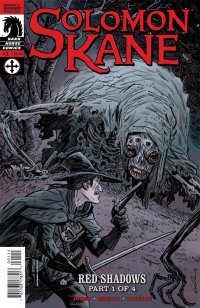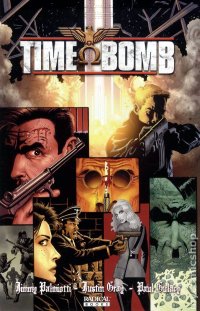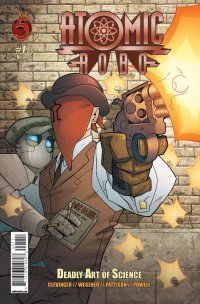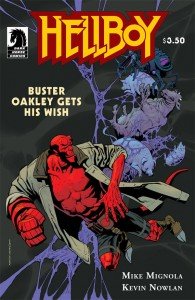Solomon Kane: Red Shadows #1, Dark Horse, $3.50
By Adam Prosser
I admit I stopped paying attention to the Dark Horse comic adaptations of Robert E. Howard a while back. It wasn’t so much that they weren’t good anymore, it’s just that they seemed to be a bit…unfocused. Solomon Kane, in particular, seemed to hit a strange hiccup—after a decent start, the series vanished from the shelves for some reason. (It may have to do with the existence of a rather lousy film adaptation starring James Purefoy, which, rightly, never got wide release; if Dark Horse had been planning to ride Solomon Kane mania…Solomania?…in the wake of the movie, those plans obviously never went anywhere.) At any rate, momentum had stalled out enough that I didn’t bother to pick up the second miniseries, Death’s Black Raiders, when it showed up earlier this year. At any rate, this issue marks a new creative team’s tenure, so I figured I’d give it another shot.
Despite setting the stage for a new series, this issue is essentially a standalone. Kane, the grim puritan adventurer and smiter of mystical evil, is still wandering around Europe (I’m not clear if he’s still in the Black Forest), putting down demonic entities and evil spirits wherever he encounters them, as some form of undefined penance. This issue is a fairly simple tale of Kane at a crossroads, literally—he’s offered a choice between a longer, harder, supposedly safer path and a route that’s purported to be haunted. Take a wild guess which one he chooses. Along the way, Kane uncovers the mystery at the heart of the haunting and sets things to rights.
It’s straightforward—a little too straightforward, honestly. This gets back to my problems with the Dark Horse Howard line. I’m a huge fan of Kurt Busiek’s first few years on Conan, when he seemed to be crafting something bigger and richer out of the familiar Howard mythos, linking the disparate stories together into a real epic story with a compelling through-line. But after Busiek left, the series reverted to…just a series of adaptations of Howard’s stories, and stories similar to Howard’s. And this afflicted the Solomon Kane series as well. Understand me here: the Howard line has been consistently strong in every department, from action to dialogue to the distinctive “stripped-down Frazetta” look pioneered by Cary Nord. But there’s also a sense that this whole sub-section of the publisher’s has begun resting on its laurels. It has its own well-deserved fanbase and sells consistently, something that very few comics outside the Big Two can claim, and this seems to have convinced the creators that there’s no further need to challenge themselves. You can argue that there’s not that much leeway to be radically original within the canon of Howard’s pulp stories, but again, I think Busiek proved that wasn’t so (and even Arvid Nelson and Will Conrad’s take on Kull had a level of wit and depth to it, at least when it begun, that showed they had enthusiasm for the material).
Solomon Kane is a compelling character, but so far his comic series has mostly seemed to be going through the motions. If you want to see an eloquent-but-grim adventurer doing battle with monsters, this comic will deliver in spades, just like the other Howard titles, but (except for Howard’s elegant prose) it lacks the lively little touches that make a comic series truly great. Much like its protagonist, this comic gets the job done, but it does so with a certain joylessness.
[Rating 3.0]
 Time Bomb (Radical Books, $14.95)
Time Bomb (Radical Books, $14.95)
by Graig Kent
Time Bomb is like a big, goofy action movie built around a B-movie plot, but pushed into the summer blockbuster realm by big budget sets and effects and name-brand stars. But even still, it’s as entertaining as it is vacuous.
The B-movie plot involves nothing less than a race against time to save the world from a long-dormant Nazi-made viral apocalypse by sending a quartet of “New World Order” agents (yes this story has its own alternate government spook agency) back in time to Nazi Germany to negate their original project. The whole thing, from the start, requires a rather huge suspension of disbelief and the ability to look beyond a lot of gaping plot holes and gaps in character logic, and were it not so well put together it would be at best laughable, at worst unreadable.
But the name brand stars – the creative team here – literally and figuratively make it work. Time Bomb is written by the writing team of Jonah Hex (and many other books), Jimmy Palmiotti and Justin Grey, and illustrated by legendary action/espionage/cheesecake artist Paul Gulacy, who provides those big budget sets and grandiose action sequences along with more than a few moments of titillation. Gulacy has been in the industry for nearly four decades and this is as strong as any of his past works, both in terms of storytelling and visual appeal. His crisp use of blacks accentuate the impeccable colors of Rain Beredo who has been working his equally stellar magic over at Marvel for the past half decade. The book quite simply looks fantastic. There isn’t a single dull page, and Gulacy nails the WWII German style and environments in both a believable and over-the-top fashion.
Palmiotti and Grey start the book off large with the discovery of an underground Nazi city and the triggering of a missile which destruction of Berlin, the spreading of an unknown plague that threatens to wipe out the Earth. This sequence occurs over 30 pages (interspersed with the introduction of the New World Order team), Palmiotti and Grey’s methodical and intense orchestration give the book the needed buy-in that permits them to lay on the otherwise silly situations that come with an air of plausability.
Time Bomb is the kind of story that Inglourious Basterds would have become had it wound up in the hands of Wolfgang Petersen. It’s big, it’s brash, and it’s unfettering in it’s American-ness without being too rah-rah. The trade paperback (collecting the original mini-series) moves along at a breakneck pace, and it’s quite engrossing as it continues to escalate in intensity and absurdity. The only real drawback is a somewhat puzzling twist included at the end which is as unnecessary as it is pointless.
It’s not high art, but it’s delicious, mindless entertainment.
[Rating 3.5]
Atomic Robo: The Deadly Art of Science #1-5, Red 5, $3.50
By Adam Prosser
Every group, subculture, or people on Earth has an inherent drive to mythologize their own history. Comics fans are no different, and there’s no more flamboyant form of mythologizing than viewing an era through the lens of comic books. Pulp culture, particularly throughout the 20th century, provides a wonderfully warped window into the hopes, dreams, and fears of any given time frame; by giving up any attempt at directly portraying how things really were, these stories can be surprisingly insightful at showing how things seemed. Of course, there’s also the nostalgia factor—whether it’s the thrill of recapturing the technological revolution of the late 19th century via steampunk, or the wild stylishness of the early 60s in Silver Age form, it always seems like the old stuff was cooler. Simpler. More inviting. None of that pesky moral ambiguity or cultural self-doubt! Take me back to a time when men were men, women were women, jetpacks were the future, and superheroes unhesitatingly plugged gangsters with revolvers while wearing awesome hats!
Such is the straightforward appeal of the latest Atomic Robo series. If you’ve been reading Brian Clevinger and Scott Wegener’s wonderful creation—and if you haven’t, you’re probably a commie—you’ll know that the titular robot is the anachronistic creation of Nikola Tesla, having been secretly on-call as a smasher of evil for much of the past century. This, of course, means that the character is practically begging to be inserted into old-school pulp, comic and SF adventures, and with this latest series we have Robo meeting up with a good, old-fashioned pre-WWII pulp superhero, a masked mystery man known as Jack Tarot, Gunfighter. Robo is immediately enthralled and dreams of escaping his “boring” life of assisting a mad scientist conduct mind-blowing experiments to fight crime alongside Jack; Jack is less enthused.
Atomic Robo isn’t a book that’s particularly known for its relentless innovation; it tends to tread over somewhat familiar comic book territory in its broad strokes. It’s the little details that make this book such a delight, along with Clevinger’s wit and humour (the book wouldn’t be half as enthralling if it took itself seriously) and Wegener’s clean storytelling and slick designs. More to the point, pulp crimefighters are inherently cool, to the point where they can easily become crutches for a lazy storyteller (just as zombies, ninjas, or dinosaurs could be), but Clevinger and Wegener are able to create a distinctively cool character in Jack Tarot, one who seems like he’s got a life of his own and could headline his own series if he had to. (I know C. and W. are never crazy about having Atomic Robo compared to Hellboy—despite the almost unavoidable similarities—but consider Hellboy’s rather overrated Lobster Johnson character; Jack Tarot is far more compelling.)
So while this perhaps isn’t the most original material in the world, it still feels fresher than the average superhero comic. And it’s fun. That is, after all, what comics are supposed to be about in the first place.
[Rating 4.0]
 Hellboy: Buster Oakley Gets His Wish (Dark Horse, $3.50)
Hellboy: Buster Oakley Gets His Wish (Dark Horse, $3.50)
By Jeb D.
One of the ideas periodically floated to sustain the superhero comics field is to abandon the monthly floppy altogether, and feature popular characters in self-contained graphic novels, as the market demands them, rather than on a forced monthly schedule. And while I doubt it was intended as some sort of experiment along those lines, that’s rather what has happened with Mike Mignola’s Hellboy: rather than being committed to churning out new material every month or two, Mignola (usually just scripting these days) and his collaborators decide they have a Hellboy story to tell, they tell it, and that’s that, with no need to twist it to fit the demands of a decades-old comic universe. And this latest volume is a good indication of the strengths, and weaknesses, of that approach.
Among other things, it’s nice that Kevin Nowlan (who, among other things, designed the Hellboy logo) is able to draw his first complete issue of Hellboy; not every great artist can keep up with the demands of regular publication, so standalone stories of this type allow a popular character to get a kind of “boutique” treatment that would be harder in an ongoing series. And Nowlan acquits himself more than well, giving the story a vibe of creepiness that synchs up well with Mignola’s iconic vision of horror, despite the storyline veering into territory that I associate more with Eric Powell than Mignola.
See, back in 1986, this kid was messing with Dark Forces, in the wooded outskirts of the farming community in which he lives, a community in which the residents seem to have a love of livestock that verges on the… not quite right. Think bad stuff happens to him? You have no idea. And there’s aliens (in a proper 1950’s flying saucer, dammit!), complete with their famous probing, cows, fights, wisecracks, more cows… yeah, basically, bad stuff happens, Hellboy gets involved, tosses off a few grouchy one-liners (he often reminds me of a cross between Indiana Jones and Jim Rockford) and beats the living crap out of anyone that gets in his way.
And there’s the problem: in order to give the story an easy entry point (you don’t need any B.P.R.D. background to enjoy it) and a sense of completeness (nothing is left unfinished with the supporting cast), you reach the end of the story with a kind of a shrug. It’s a fun read (and, as I say, has a kind of retro-horror-movie vibe that’s a change of pace from Mignola’s usual Lovecraftian dread), but is also more or less interchangeable with most other recent Hellboy books: one of the things that a monthly comic title in a shared universe can provide the reader is a feeling of immersion in a larger ongoing story, and the sense that the actions you’ve just been reading about will have consequences down the road. That’s not always the case, of course, but this sort of closed-off graphic novel (even when presented as a 22-page pamphlet) denies us much of that (particularly when it’s deliberately set in the past to provide a further remove).
This book would probably make a good introduction for a new Hellboy reader; for anyone who’s already familiar with the character, buy it if you’re a big Nowlan fan or a Hellboy completist; others can probably skip it.
[Rating 3.0]
S.H.I.E.L.D. Infinity One-Shot (Marvel, $4.99)
By Jeb D.
I’ve never felt that the Marvel Universe was in need of decades or centuries of backstory: as far as I’m concerned, all the good stuff began when JFK was President, Cap and WWII were just a memory, and there was no Sentry to make Reed Richards look like a goofy slimeball. But there’s plenty of comics fanboys and writers (and Roy Thomas, who is the perfect storm of both) who (in what I tend to think of as a bad case of DC-envy) just can’t help wanting to extend the roots of Marvel’s superhero universe deeper and further back than the Space Age.
I won’t bother listing the dozens of (IMHO) unsuccessful (or, at best, half-successful) attempts at this (did I mention that I’m not a huge fan of The Sentry?), but I have to give credit where it’s due: with his work on S.H.I.E.L.D. (and the FF), Jonathan Hickman is pulling it off, and I eagerly await the next series.
But that’s not what this is. It’s a well-written, pricey, series of flashback stories that, while we’re waiting, detail the influences of Archimedes, Nostradamus, Leonardo Da Vinci, Isaac Newton and Nikola Tesla on the mysterious ancient order from which Hickman derives his version of S.H.I.E.L.D. Each story is illustrated by a different artist, and each one shines with Hickman’s ability to create unique voices for characters of this type, as well as his confident plotting, giving small reveals here and there of mysteries from the first series, while planting seeds for the second. The art ranges from an excellent approximation of Dustin Weaver’s work on the regular series (from Nick Pitara on the Leonardo section, which features a wonderful punch-up that I won’t spoil) to adequate to indifferent (neither Zachary Baldus, Kevin Mellon, or Gabriel Hernandez Walta are exactly in Marvel’s top artistic echelon).
I hate to be dismissive of a new book from one of my favorite writers working today, but I can’t help but feel this is just marking time: you could have tossed any one of these into a regular S.H.I.E.L.D. comic as a backup feature and you would feel no lost sense of urgency at their not being joined in a single volume. And, as I say, an expensive volume, relatively speaking. I won’t say it’s not a good comic–it is–but (rather like the latest Hellboy, actually), it’s not an essential one… and coming from Hickman, that’s pretty rare.
[Rating 3.0]